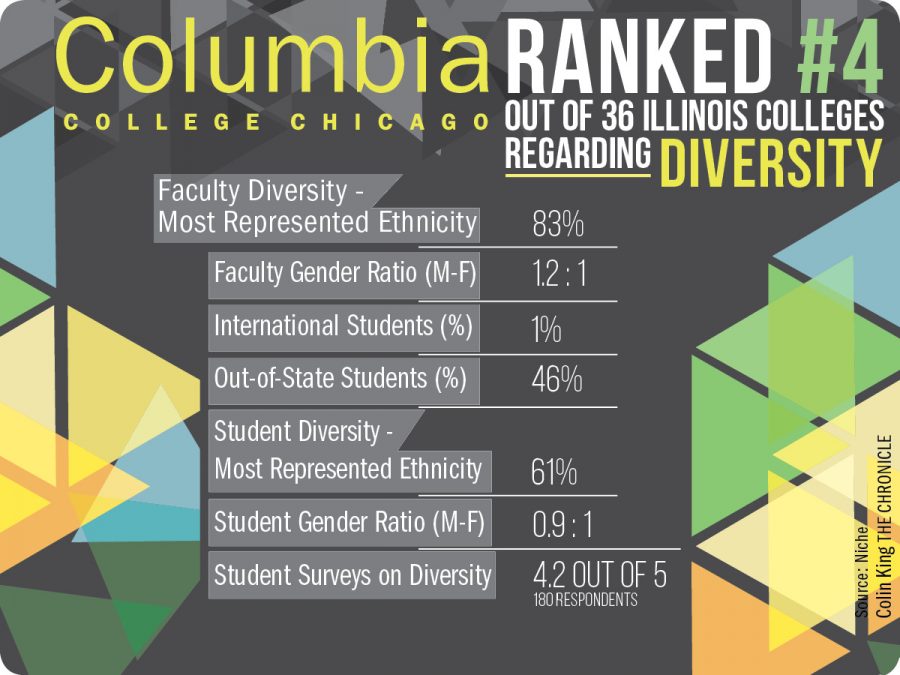College finds ‘Niche’ with diversity ranking
College finds ‘Niche’ with diversity ranking
January 26, 2015
In early January, Niche, a website that provides reviews and expert insight about schools and other organizations, released a ranking of colleges based on their excellence in campus-wide diversity, and Columbia ranked fourth among 36 Illinois colleges.
Several factors were taken into consideration to calculate Niche’s rankings, including diversity of viewpoints, backgrounds, religious beliefs and sexual orientations among students and faculty, according to its website.
According to a Fall 2013 report from the college, 82 percent of full-time faculty and 85 percent of part-time faculty classify themselves as white, non-Hispanic. The remaining 18 percent are of different ethnicities and cultures, according to the report.
While Niche’s ranking was high and did not shock administrative leaders at the college, the college-released faculty diversity statistics report suggests diversity among faculty on campus still might be lacking.
Stan Wearden, senior vice president and provost, said the ranking does not surprise him, but faculty diversity still needs improvement.
The report states Columbia’s student body is more diverse than its faculty, with 56 percent identifying as white, non-Hispanic, leaving 44 percent minorities.
As the Strategic Plan pushes forward through the Spring 2015 semester, a closer focus on faculty diversity is due to the disproportionate statistics between the college’s faculty and students, Wearden said.
“I would really like us to have a faculty that reflects the diversity of our student body and the diversity of the city of Chicago,” Wearden said.
Having a faculty less diverse than the student body could decrease retention rates, so the Strategic Planning Board is creating a plan to ensure students have a diverse range of faculty members to relate to, Wearden said.
“We understand the importance of recruiting faculty,” Wearden said. “We’ve lacked a real plan to make sure we put a strong emphasis on that and that in every faculty search committee, we [have] somebody in charge of making sure we get a diverse pool of candidates.”
Mark Kelly, vice president of Student Success, said the college is always seeking to increase diversity, and it is a primary goal to create a curriculum focused on incorporating diversity at the college.
“We’re going through a strategic planning process and two themes have emerged,” Kelly said. “One that the college has to be more attentive to issues of faculty hiring and two [being] that diversity is something that’s truly part of Columbia. There are still issues with parts of the curriculum where diversity is not part of the vocabulary and perspective of the class.”
Kelly said a key principle to student success is to expand diversity, starting at orientation and continuing throughout the rest of students’ time at the college.
“Our responsibility is to develop citizens of the world who see the world with all of its complexities and challenges, and diversity is central to that,” Kelly said.
Kimberly Weatherly, director of Multicultural Affairs, said diversity is important to Columbia, and the college must adhere to its mission statement of being “an urban institution whose students reflect the economic, racial, cultural and education diversity of contemporary America.”
“When I think of Columbia, I think we try to adhere to our mission to be inclusive and we don’t get it right all the time,” Weatherly said. “But we do a spectacular job, and I think we’re ranked high [on the Niche list] because our students are very happy here.”
However, Weatherly said the college’s reputation speaks for itself and Columbia is already well-known for its strength in diversity. She said the college earned its high ranking by practicing what it promotes.
“[Diversity] is important in a lot of different ways,” Wearden said. “One of the most important things to learn in college is the experience of people who are not the same as you, to learn about and become sensitive to the multicultural city and world we live in. We can certainly build a curriculum that teaches that, but a big component of being able to do that effectively is to make sure our faculty itself is diverse, too.”








